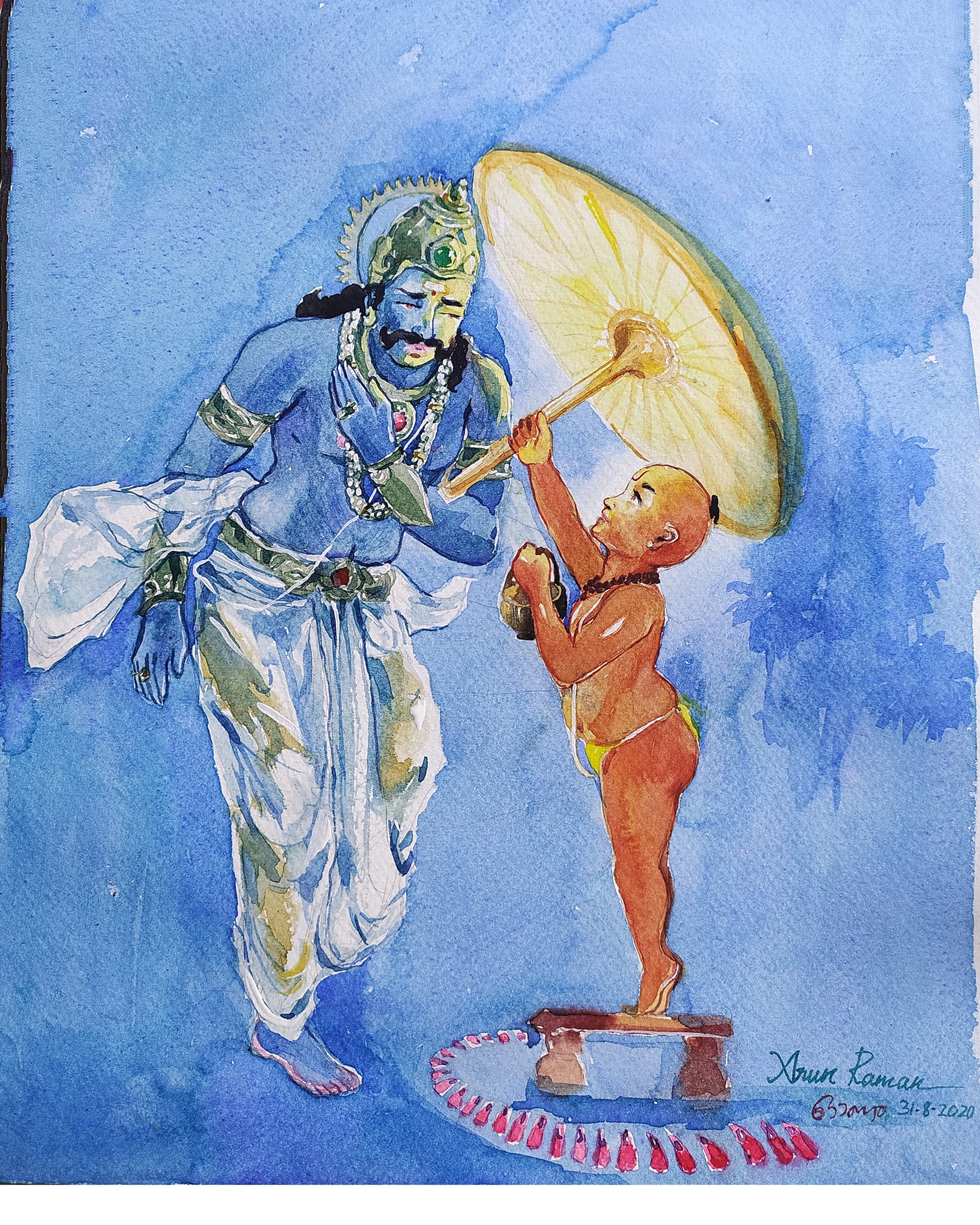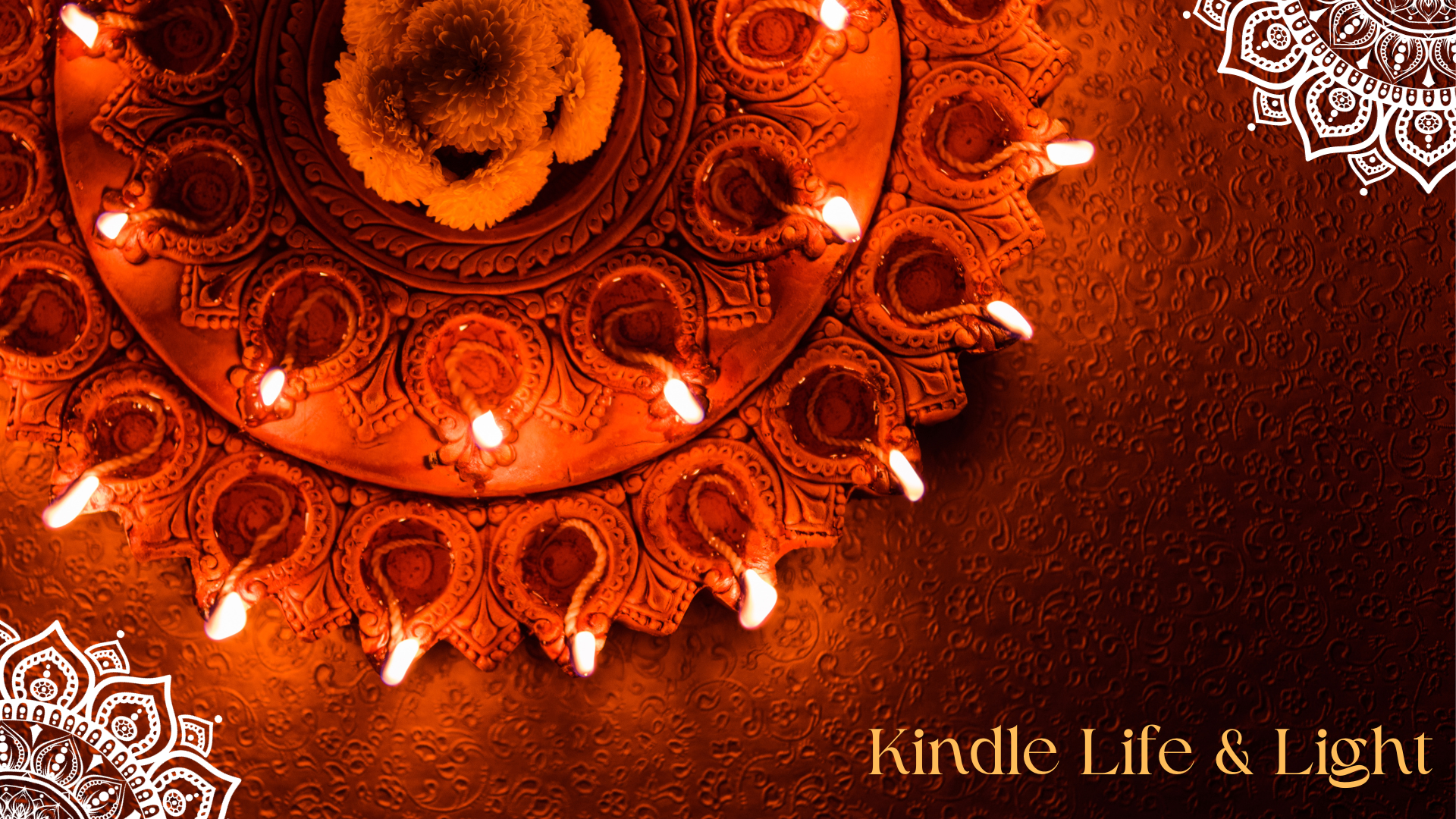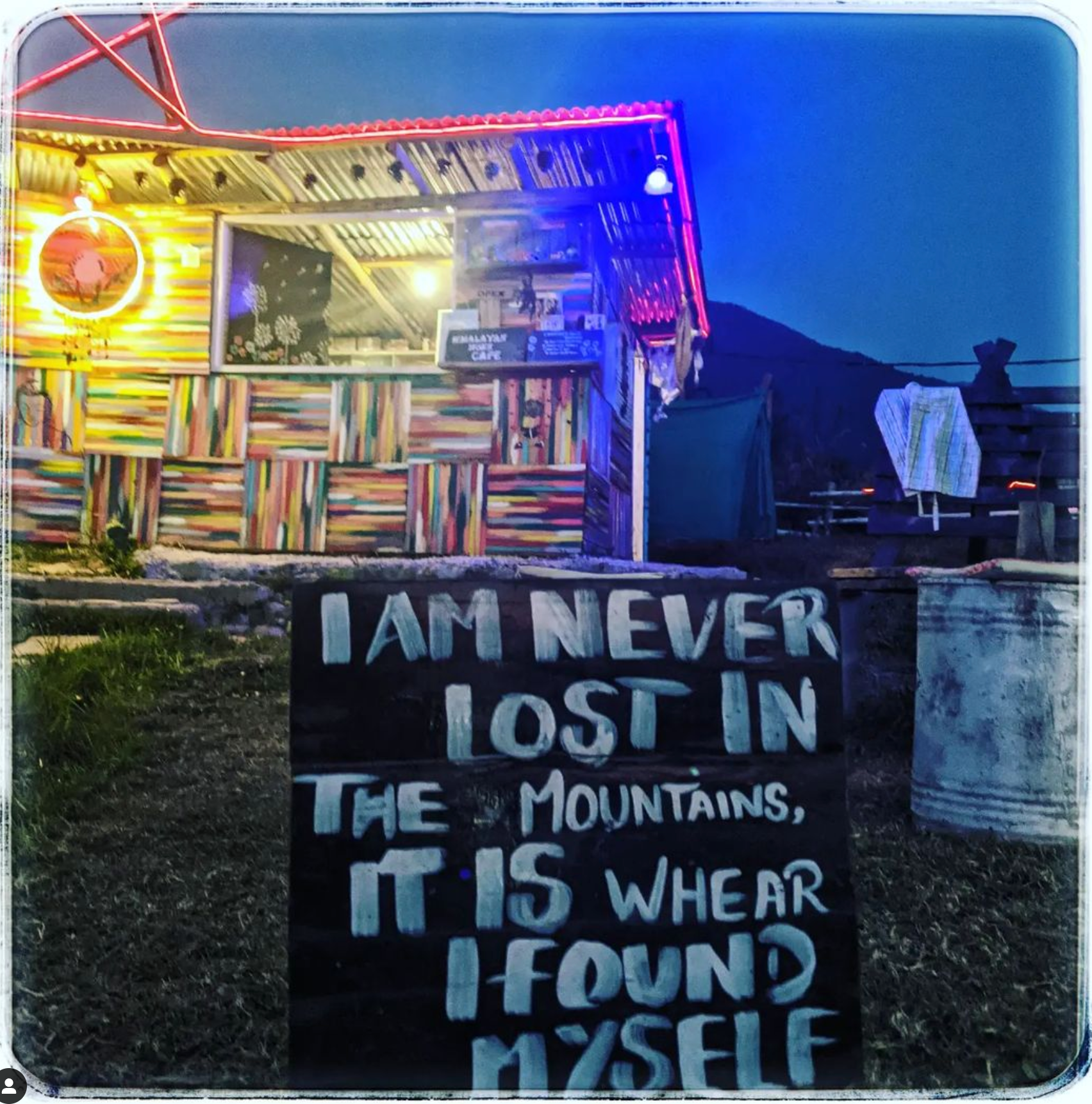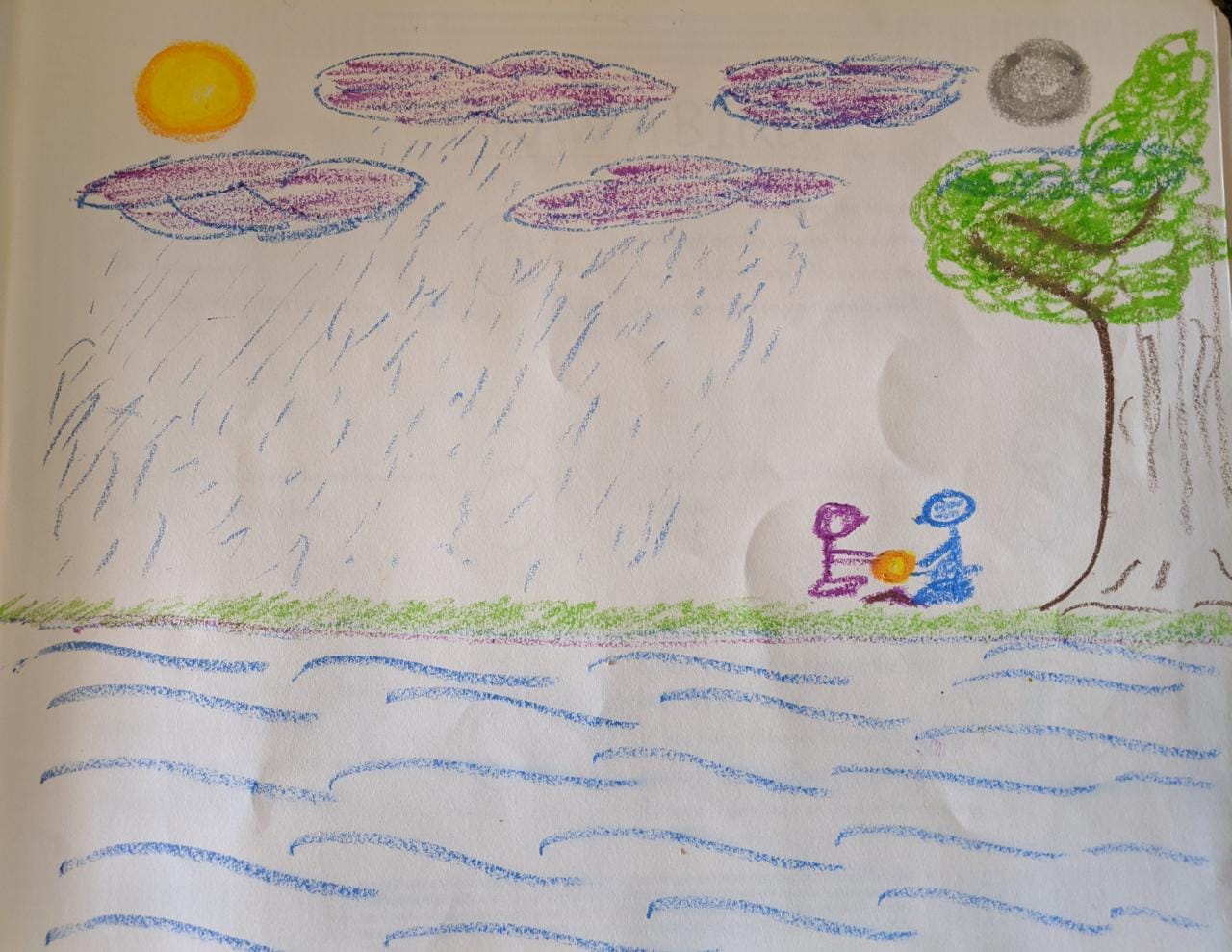Onam festival is a quintessential part of the identity of Keralites. Onam is truly an all-inclusive festival that is celebrated across caste-religious divides in Kerala. However, the understanding of the origins of Onam festival and the central figures in its legend Vāmana and Mahabali seems to have undergone many distortions to the extent that most Malayalis who celebrate the festival today do not know of many of its significant aspects. It came as a shock to me few years back when I did some reading on this festival, and realised how little I knew of this most important event in Kerala. And so began my attempt to rediscover Onam for myself.
What is Onam?
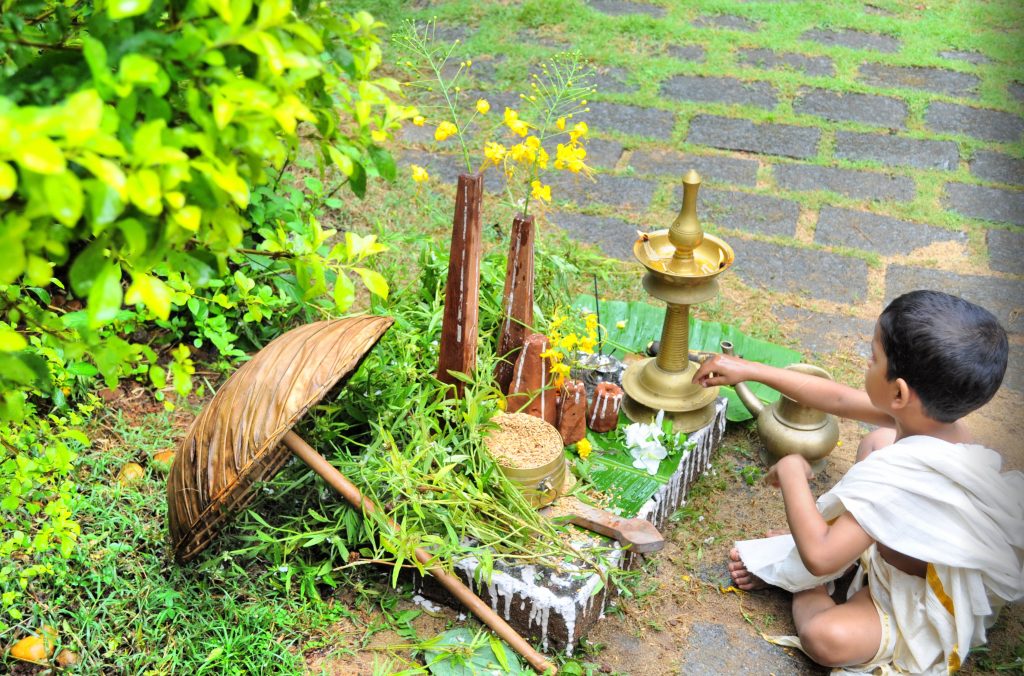
Onam is a festival that celebrates the birth of Mahā Vishnu’s ‘Vāmana’ avatār. The legend of Onam is derived from Srimad Bhāgavata Purāna (Canto 8 / Chapters 15 to 21). The popular misunderstanding is that Onam is a celebration of the annual visit of an ancient King of Kerala by the name ‘Maveli’ or ‘Mahābali’. While Vāmana and Mahabali have a direct connect which is found in many scriptural references. However, there is no connection established between Mahābali and Onam.
Onam celebration is linked to the Trikkākkara temple in Cochin which has Mahā Vishnu in the form of Vāmana mūrti as the presiding deity. Trikkākara temple is one of the very rare temples where festival happens during Dakhinayana (Pitr Paksha). Dakshinayana is the six-month time period between Summer solstice and Winter solstice, when the Sun travels to the South of the celestial sphere. According to Puranas, Dakshinayana marks the period when the Gods and Godesses are in their celestial sleep.
King Mahabali in Puranas
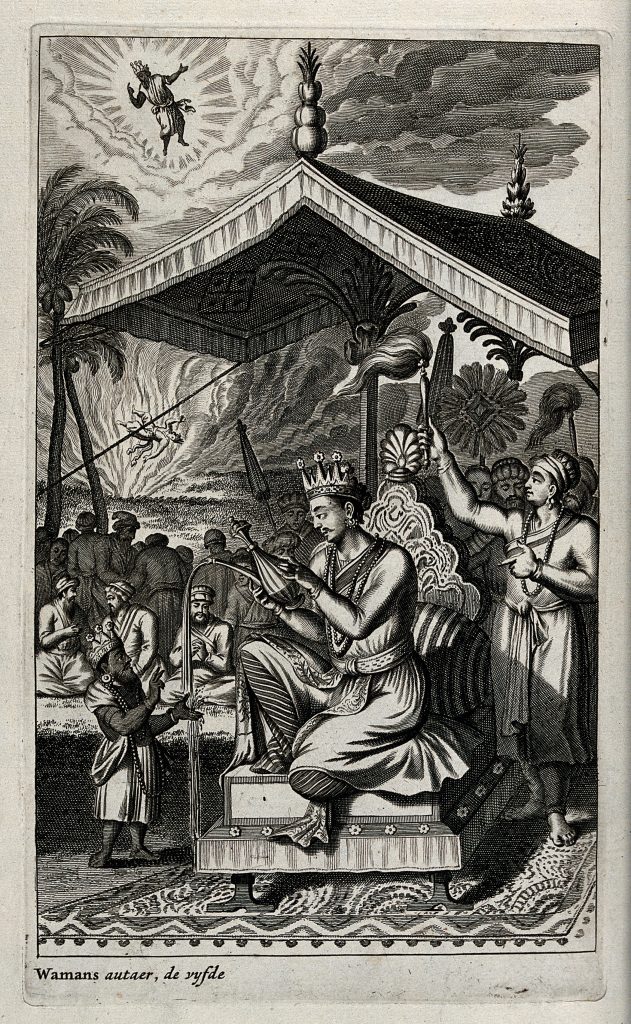
In the fight that ensued after the Samudra Manthan, Devas had defeated Asurās. Indrasena is the original name of Bali mentioned Puranas. He was the grandson of Prahlāda, the famous Vishnu devotee and son of Hiranya Kashipu. Asuras under the leadership of Indrasena and guidance of their guru Shukracharya’s Vishwa Jeet Yāgam, conquered all the three worlds including Deva Lokam. Owing to his tremendous strength (Balam), Indrasena came to be known as Bali. To attain the status of Indra, Bali started preparations for the 100-th yāgam. Vāmana was born to subdue the arrogance of King Bali. Only when King Bali surrendered himself by bowing the head in front of Vāmana did he became ‘Mahābali’.
Birth of Vāmana
When Bali and the army of asuras conquered all the three worlds, Devas pleaded to Mahā Vishnu for a resolution. Bali was a great devotee of Vishnu, and so he did not want to take any direct action against Bali. However, Vishnu promised to be born to Deva Māta Aditi (mother of Indra) to find a resolution for the sorrow of the Devās.
Vishnu took birth as Upendra to Kashyapa and Aditi. Upendran literally means younger brother of Indra. Since he was transformed into a Bāla Brahmachari immediately upon birth, he came to be known as Vāmana.
Bali – Vāmana Encounter
As Vāmana entered the Yāgashāla, Bali immediately recognised that this boy was not who he seemed to be. However, he welcomed Vāmana in accordance with all the ritualistic requirements. Bali then offered Vāmana to ask for anything from him. However, Vāmana simply asked for 3 feet land for doing tapas (penance). Bali’s guru Shukracharya sensed danger at this point and urged Bali not to proceed. However, Bali was adamant that he should keep his word. Shukracharya curses Bali to lose all aishwaryam (abundance) as he disobeyed the Guru. Bali proceeded with the promise of allowing Vāmana to take three steps of land that he needs.
When Bali was about to pour water into Vāmana’s hands to seal his oath, Shukracharya entered the vessel after reducing his body in size, and blocked the hole from which water flow. As if to remove the small blockage, Vāmana inserted a straw into the hole and struck the eye of Shukracharya, who left in utter pain. The water then flowed freely into the lotus hands of Lord Vamana. (Nrisimha Purana 45.34–37).
Vāmana immediately grows in size to become Trivikrama. With one feet, he covers the entire Earth. With the second feet, he covered the swarga lokam. Having no land left, Vāmana asks Bali where to take the third step. Bali woke up to his arrogance and surrendered with all humility in front of Vāmana offering his head as the place where he could take the third step.
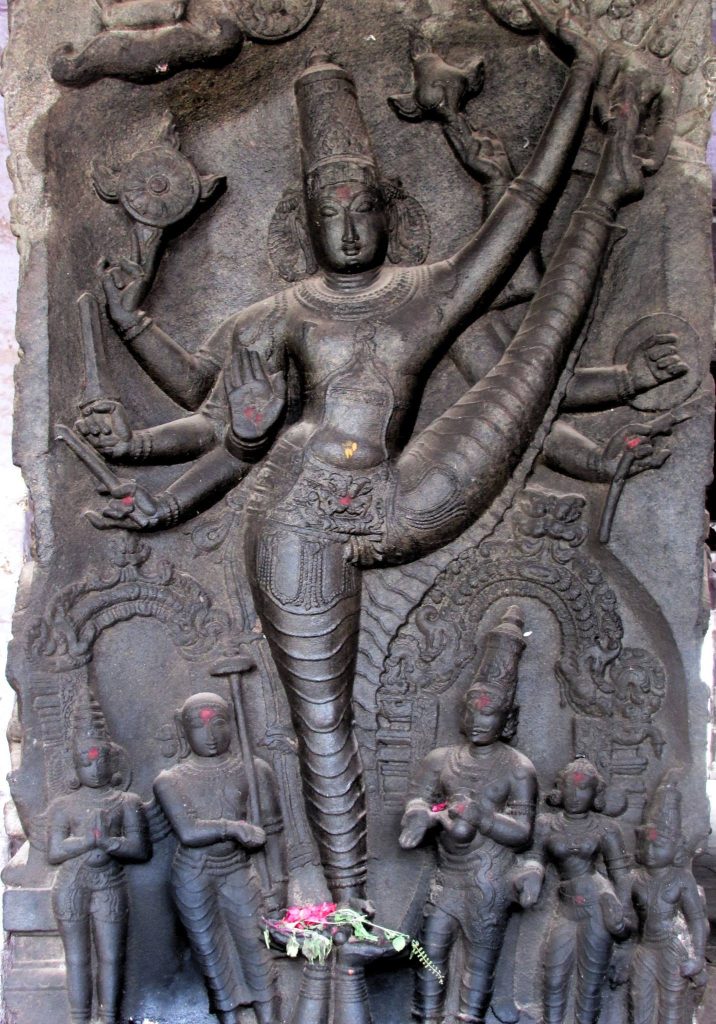
The third step of Vāmana on the head of King Bali is an instance of Tiru-adi Dīksha tradition. With Vāmana’s blessing, the ignorance of King Bali was removed and he attained Mukti and became ‘Mahābali’. Mahābali was promoted to ‘Sutalam’ (auspicious region). Vishnu confirmed that once the present Indra steps down from his position, Mahābali would be granted the next Indra status. Not just that Vishnu also blessed Mahābali with the ability to see him at all times. What greater joy can a devotee have?
A popular misconception is Vāmana ‘punished’ Mahābali and sent him to ‘Pātālam’ (netherworld). This is a complete distortion of the story depicted in Purānas.
Was Mahabali a King of Kerala?
The yāgashāla according to Bhāgavatam was set up to the North of River Narmada in a place called Bhrigu Gaccham. Some scholars say this is present-day Rann of Kutch while others opine it is Bharuch. There are reports that cite remote sensing, geological, and archaeological evidences in recent times suggest a large river flowing through Rann of Kutch in ancient times. However, there is no reference to Kerala. Ancient scriptures also talk of ocean to the West of the Western Ghats. Today, Kerala is to the West of Western Ghats and then we reach ocean. Kerala is also characterised by an abundance of Calcium Carbonates in the soil of Kerala. General consensus among scholars is that this level of Calcium Carbonate deposits are usually found in landmasses which used to be submerged in ocean earlier. The rock formations in Kerala also match the kind of rock formations that are found under water in sea (rounded mostly). These indicate present-day Kerala may have been below sea in ancient times.
All this implies it may be incorrect to equate Mahabali to Kerala. However, there is no way to assert it is true or false. All we can do is to look at some of the historical writings in the context of Kerala to arrive at an educated guess.
Sri Kodungallur Kunjikuttan Thampuran (Rama Varma), renowned poet who is famous for translating the Mahabharata to Malaylam verse-by-verse is known as Kerala Vyāsa. In his khanda kāvyam (epic poem) ‘Keralam’, mentions how the Venād Adikal (rulers of Venād) conquered Kochi Kingdom and remained at the Trikkakara Temple in Kochi to receive offerings from the elite of Kochi Kingdom. Trikkakara temple is a renowned temple of Vāmana Mūrti in Kerala. It is believed that the procession leading up to the temple to give offerings to Venād Adikal culminated in the celebration which became Onam. There is version which talks of Ittu Ravi as the King who started this tradition. However, Indian historian Ālappāt Sridharan Menon in his books on Kerala mentions Raja Kulaśekhara Āzhvār as the one who instituted Onam as a festival of the Chera Nādu (Chera Kingdom). Either ways, he also clearly establish that there is no relationship between Onam festival and Mahābali.
While Mahābali may have been a noble King of the Pauranic times, it is incorrect to say he was a King of Kerala. If you read the legend of Vāmana in conjunction with the next avatār of Vishnu, Parashurāma (Rāma with an axe or Paraśu), this becomes even more evident. Legend has it that Kerala was a gift from Arabian Sea to Sree Parashurāma, a.k.a Bhārgava, who threw his axe across the Sea from Gokarna to Kanyākumāri, and water receded up to the spot where his axe fell. This is also the reason why this region which includes Kerala is referred to as “Bhārgava Kshetram” or “Paraśurāma Kshetram”. If one were to believe Mahābali ruled a land during the times of Vāmana, then clearly it is illogical then to say that land was Kerala which was formed during the time of Paraśurāma who came after Vāmana.
Political Distortions of Onam in Modern Times
Honestly, I could not figure out when the legend of Mahābali crept into the celebration of Onam. However, the importance of understanding important festivals such as Onam that form part of the identity of a population becomes very evident when one looks at the ways in which the distortions to the legend of Onam and Mahābali is being used to further identity politics of various kinds.
This year Mr. Thomas Issac, Finance Minister of Kerala, from the ruling Communist Party of India (Marxist), tweeted a controversial statement which promotes the popular misconception around Onam.
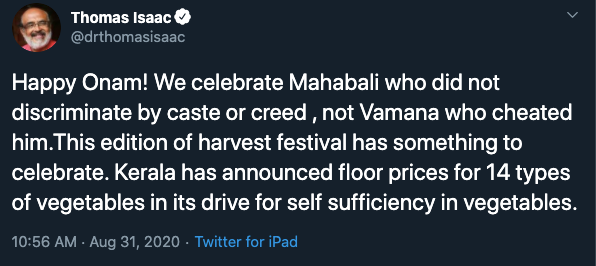
It is understandable if a layman passes off statements of this kind out of their ignorance. But coming from a responsible Cabinet Minister of a ruling government, it is very unfortunate. The only way to counter statements such as these for petty political brownie points is to spread awareness of the truth of Onam to the maximum number of people.
It is very interesting to note that even popular literary writers from Kerala have went along with this version of Onam – Mahābali connection.
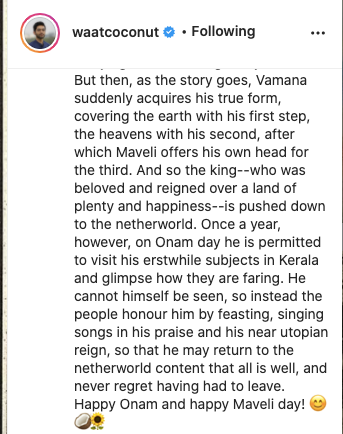
I’ve also come across ‘woke’ Malayalis who goes with the current trend of creating content that propagates these distortions. While it may be fashionable now to interpret anything and everything as a subaltern resistance against savarna domination, it may be good to dig a little deeper as sooner or later, such activism and activists are bound to lose their credibility when the layman starts understanding the truth and essence of Onam.
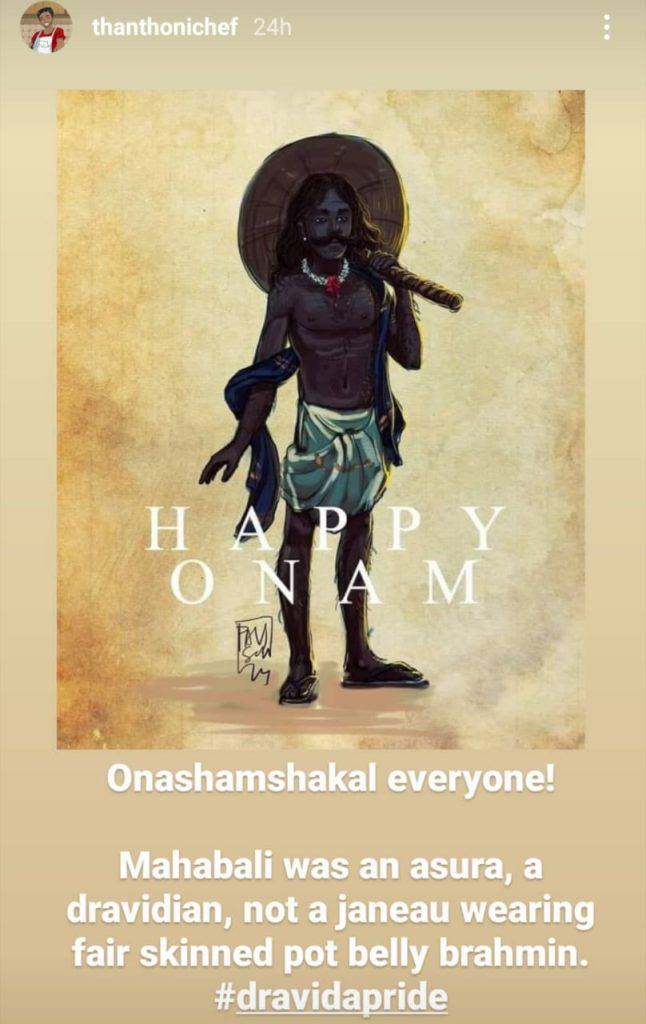
Rediscovering & Reclaiming Onam
Rediscovering and reclaiming Onam is a rnam (duty) that every Keralite owe to their ancestors. Let each Onam bring greater connect to the Vāmana Mūrti at the center of that pookkalam (floral carpet), reminding us of the eternal Purusha within that enlivens the Prakrti and allow us to unfold and bloom into our full potentiality.
The legend of Vāmana and Mahābali has great potential to evoke a self-reflective journey for an individual. To me, this story clearly drives home the importance of the idea of īśvarapranidhana (surrender to a higher entity that one believes in) mentioned in Kriya Yoga (Tapas, Svādhyāya, Īśvarapranidhana). As long as I hold on to my sense of self that is rooted in my past experiences (desires and aversions), I will not be able to allow my highest potential to manifest. Can I trust the flow of life and allow the grace of the guru parampara to flow through me, and be a joyous witness to the life divine that unfold effortlessly? This is what I am staying with after yet another Onam and revisiting the journey of Bali to Mahābali by the grace of Vāmana.
How are you evoked when you delve into the story of Vāmana and Mahābali? I’d love to hear your thoughts and reflections.
